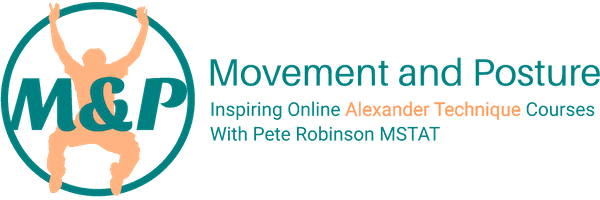Every day, thousands of people injure themselves through lifting objects in a way that places too much stress on the body. By applying the principles of the Alexander Technique to lifting, you can find a better, safer way to lift and avoid the pain!
I’m Pete Robinson from Movement and Posture.com, I’m a qualified AT teacher and I’m really pleased to be able to share the benefits that AT can bring to your posture, movement, health and performance. I’m releasing new videos every Sunday so subscribe to the channel and ding the notification bell so you don’t miss out.
In this video, I’ll explain the AT approach to lifting and then take you through some examples. It’s all pretty simple which means that you should be able to get the hang of it really quickly and put it into use straight away. If you’ve seen any of my other videos, you’ll know that there are some ideas which keep coming up: Being more aware of your whole self, balance, habits and avoiding unnecessary tension and compression These ideas are really key to being able to make permanent improvements to the way that you move and of course, the more areas of your life that you apply AT to, the more skilled you get at making these improvements The Alexander approach to lifting is that your main priorities are: staying aware of the whole of yourself so you can notice what’s going on accurately, deciding to not allow the movement to happen in your habitual way and then making the movement without losing balance or compressing yourself.

“So, if I were to use the AT to lift the object. I would be doing several things. Firstly, I would STOP and refuse to let my habitual movement take place..”
LEVEL 1:
Lifting a light object from a table
If I have to lift an object from a table for instance to put it on a shelf or in a cupboard, my habitual way of moving may include bending forwards by curving my spine which causes my body to compress and go out of balance.
This means that muscles in my legs, back, shoulders and neck have to tighten to compensate.
As I then use my arms to lift the object, this puts even more tension into these muscles.
Although the object is light, if the movement is awkward enough, it may still be enough to cause pain or a minor injury such as a muscle spasm.
So, if I were to use the AT to lift the object. I would be doing several things. Firstly, I would STOP and refuse to let my habitual movement take place.
Next, I would choose to become really aware of the whole of myself so that I can accurately tell whats going on in my body.
Then, I would prioritise being in balance, releasing my weight down into the ground through my feet.
I would also make the decision to not compress or fix any part of myself so that the natural expansion upwards and outwards can return to my body and that I’m free to move.
I’m now in a good state to start the movement.
I’m going to move so that I’m holding the object. But, I’m going to keep prioritising being aware of myself, staying in balance and not compressing or stiffening myself as being more important than reaching the object.
If my movement causes me to lose awareness, lose balance or compress myself in any way then I’ll stop and start again.
By following this simple instruction: changing the priority from what you are doing to how you are doing it, you have a chance of breaking your old habits and discovering better ways of moving.
Once I have the object, I will again prioritise awareness, balance and not compressing myself.
I’ll stand up to full height and keep the object close to my body. I’m including the weight of the object into my own weight and I’m expecting it to be supported by the floor rather than grabbing the weight with my muscles.
As I go to lift the object, the same principles apply. I’m keeping my awareness, balance and decision to not compress as top priority and as a result, the object remains supported by the floor and my whole body works in a coordinated way to make the lift with the minimum of effort.
Hopefully that made sense to you. It may take a few goes to really get the idea but you should fairly quickly be able to notice that lifting in this way is much easier.
LEVEL 2:
Lifting a light object from the floor
Let’s up our game a bit now and lift something from the floor. Firstly, a light weight so that we can practice the movement with less chance of straining yourself if you get it wrong.
To pick up the object, I’ll use exactly the same process as before. The only difference is that we need to travel downwards much more. For most people, a downward movement in the body is achieved by bending the spine, losing balance and using a lot of tension and compression.
If we move in that way, it’s no wonder that as we get older, we rapidly find that moving to the floor becomes more and more difficult or even impossible. The way our body is designed to lower itself is by folding the legs up, not compressing the spine.
To do this, we have to keep our knees releasing forwards while our hips release backwards.
I go into some detail about this movement in my video about sitting posture so if you fancy checking that out, I’ll link to it above and in the description.***
So, as before. I STOP, refusing to let my old habitual way of moving happen.
Again, I prioritise awareness of my whole self, my balance and deciding to allow my body to expand and be free. As before, I keep those priorities while I make the movement downwards until I reach the object.
Of course, if I realised that I had lost awareness, balance or stiffened up at any point, I would abandon the movement, reset and start again.
I’m now low enough to get a good hold on the object and as before, I keep the same priorities and stand up to full height whilst allowing the weight of the object to release through me and into the ground.
By moving in this way, you are never out of balance or trying to lift the object while already holding muscles tight so the chance of hurting yourself is massively reduced.
LEVEL 3:
Lifting a heavy object from the floor.
Unsurprisingly, It’s exactly the same process but the stakes are higher because if you try to lift the object while you are out of balance and muscles and joints already have excessive pressure on them, you stand a much greater risk of injury. Only attempt this if you really feel like you have mastered the process.
Getting set up for the lift is the same as in the other examples. Moving down in space is the same as with the lighter weight
As you go to stand up, really make sure that you are allowing the weight of the object to be transmitted through your skeleton and into the ground.
Don’t attempt to grab the object by stiffening the arms, just slowly straighten your legs to stand up and all of your muscle groups and joints will work in a natural, coordinated way.
If you feel like you can’t safely lift the object because it’s making you lose balance or tense up then abandon the mission and get someone to help you – a huge number of lifting injuries result from unnecessary heroics.
When you are practising these movements, you are breaking habits that you have had for years. This can take quite a bit of effort and it may be difficult at first as your habits will be really strong.
Of course, once you’ve got the hang of it, your improved way of moving makes it much less likely that you will hurt yourself, lifting things becomes much easier and you are more likely to be able to retain your strength and mobility into your later years.
I hope that all made sense. Give it a try and if you have any questions or comments, drop me a line below.
If you’ve found this video useful, hit the thumbs up to let me know and have a look at some of the other videos on the channel and as always, let me know if you have any topics you’d like me to cover in a future video.
Bye for now!

